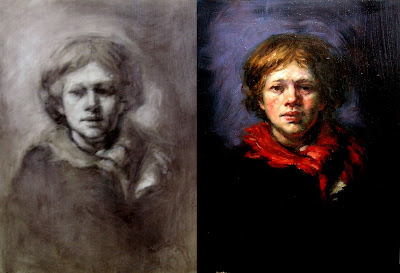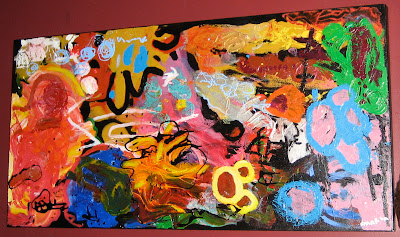
It's helpful with students who are new to painting to isolate different elements so they can learn the technique and not focus on juggling. The strengths of this are great for learning, the artist can isolate drawing and value problems first, let it dry, and then tackle color.
So, with this in mind I would like to share with you the
grisailles wipe out technique (image on the left). What you see of the light is the ground showing through. I reserved the use of white for highlights. Instead of black and Trans red oxide listed below, I used only Chromatic Black (Gamblin).
Under-painting methods: The Grisailles
Materials:
Oil paints: Burnt Sienna or Transparent Red Oxide, Cold Black or Ivory Black, White (I use Gamblin flake white replacement, but Permalba white is a good one too).
Medium: Refined linseed oil, solvent (I use Gamsol because it is the least harmful to your lungs).
Brushes: A 1” house painting brush for blending or a large fan brush, One filbert about as thick as your thumb, One smaller filbert, and the smallest should be a round maybe a # 4.
(The important thing is that your brushes are not too soft or too hard. Bristles tend to be inflexible, and sable brushes are too soft so that you can’t control them. I prefer mongoose hair, which is in between leaning toward bristle, but these can be expensive. One can find a nice synthetic that should do. To test them, press the tip down and to the side with your finger, the hairs should spring back into position when released.)
Surface: Panel or canvas, around 24”x36” is a good size. Make sure it is prepared with a dry ground (will be explained later).
Easel: This is a must, because you cannot observe accurately if you have to keep looking down at a table. You can find small table-top easels for fairly cheap. The important thing is that your surface is vertical.
Palette: Just a hard surface to mix paint on, preferably white or grey (these colors give you the ability to clearly see your paint color and value without distraction. One can make a great one with plexi-glass on top of half inch foam core cut the same size and duct taped around the edges. This is easy to clean up and can be wiped down with solvent.
Containers: You will need something to hold your solvent (old olive jars with lids work great) and smaller containers for your medium.
You will also need some paper towels, a kind that is somewhat soft. I prefer the blue rolls you find in automotive stores because they don't release fibers.
The Ground:
Mix a grayish neutral with your burnt sienna, black and white. (I prefer to lean more towards blue, like faded blue-jeans) It should be a little lighter than a middle gray-see grisailles above. Cover your surface with an opaque layer.
If you use oils for the ground, make sure you give them ample time to dry (36 hours should do it) before you paint on it. Acrylics are great for grounds because they dry within a few hours.
Preparation:
Set up the subject with a strong light source. This makes it easier to see the value relationships and can be quite beautiful as well. It’s good to paint at night, so you don’t have a lot of light from windows coming in. If you work during the day, try to block out light with black curtains or something.
Make sure you have room to set up your easel a few feet away.
If you are right handed you should set up with your still life to the left, and your easel on your right at an arm’s length, and the opposite if you’re left handed.
It is very important that your easel and surface are nearly vertical and set up in this way, because it gives you the ability to quickly glance back and forth (with your eyes) from your objects to your painting without moving your head. When you move your head your perspective of the objects changes! And you will have distortion in your painting.
The Method:
Mix 50% trans red oxide and 50% black on your palette.
Mix 50% linseed oil and 50% solvent in your small container.
Add some of these two mixtures together in equal portions, this was called “the sauce” in the French academies (save some of your oil paint without medium for later).
Cover your entire surface with a thin, semi-transparent layer of “the sauce” and lightly blend with a rag until it’s fairly uniform.
Looking at your subject, make a light sketch of your composition in simple contour lines using the oil paint mixture with no medium. You should be able to get long smooth brush strokes painting into the medium on the surface. If not, then you need more solvent in your mixture. You can compensate by adding a little medium and drawing with that. Remember;
Rules for drawing:
Work from light to dark. Always draw out the entire composition lightly first. If you make a heavy mark, it is harder to change than if you make a light mark. You can always go back and redefine and darken lines later.
Work from general to specific. Start with large ideas and large relationships first, the detail comes much later. Example: light area and shadow area. Squint your eyes.
Work from large shapes to small shapes. Accuracy is first in how large shapes relate to other large shapes
Work the total surface. You cannot move on until you know how each form relates to each other form in the entire composition.
Once you have your basic relationships between large shapes set up and your drawing is where you want it, Wipe out your major light shapes with your paper towel or rag.
Further build up the light mass with only your large filbert. (Use only the large brush in the beginning and for as long as you can, then your medium brush, then your small brush. Small brushes are for detail and detail comes last.)
(If you’re not sure where the change is between light and shadow, hold your brush over the questioned area of the object. If the shadow that it casts is visible, that is light mass. Where it disappears is shadow.)
You want your major light masses blocked in before you move on to other values. One way to get a good idea of the major light/shadow forms is to squint your eyes. This simplification is essential in starting the painting. As you develop your value remember the elements of
Chiaroscuro, or light and shadow
Highlight: the lightest light, or reflection on object.
Light mass: the major area of light.
Turning: where the light mass meets shadow.
Shadow: general area of shadow
Core of the shadow: the darkest portion of the shadow. It may be subtle and hard to see, but every shadow has one.
Cast shadow: the shadow made by the object on another surface, such as the table it is on or another object beside it.
Reflected light: light bounces off of another object that is light and may create a lighter area within your shadow. Some people like to leave this out (Caravaggio) but if you choose to have reflected light, remember that it is still shadow and cannot be as bright as your light mass, because it shouldn’t compete with your light.
Edges: If you look at a piece of paper, the edge is always sharp and hard. But if you look at a round object, like a shoulder or face, the edge is soft and fuzzy. You want to exaggerate this in your painting to make it look as if it turns in space.
Identify the elements of light/shadow… also notice which edges are hard, and which are soft.
Cast shadows are never hard edged. They become even fuzzier as they move away from the object that makes them.
Learn, experiment, and have fun!
But come back tomorrow, I'll discuss glazing techniques.












































